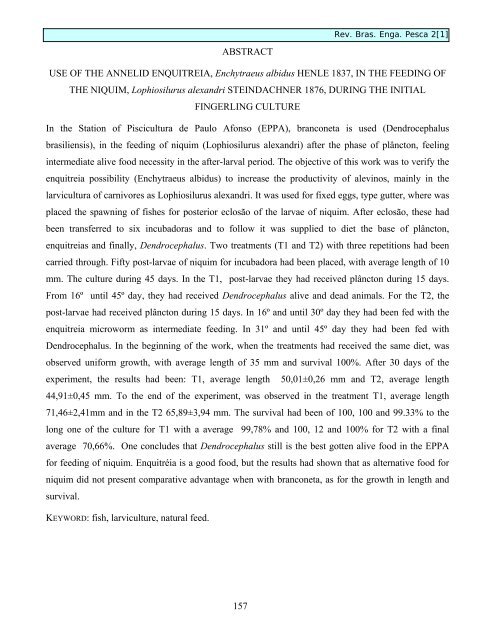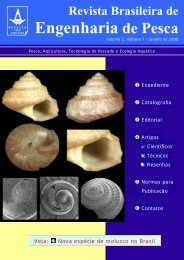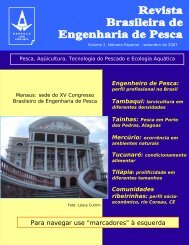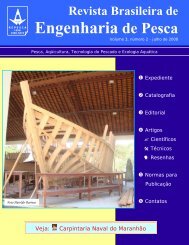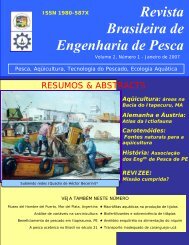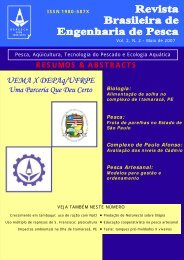Revista Brasileira de Engenharia de Pesca
Revista Brasileira de Engenharia de Pesca
Revista Brasileira de Engenharia de Pesca
Create successful ePaper yourself
Turn your PDF publications into a flip-book with our unique Google optimized e-Paper software.
ABSTRACT<br />
157<br />
Rev. Bras. Enga. <strong>Pesca</strong> 2[1]<br />
USE OF THE ANNELID ENQUITREIA, Enchytraeus albidus HENLE 1837, IN THE FEEDING OF<br />
THE NIQUIM, Lophiosilurus alexandri STEINDACHNER 1876, DURING THE INITIAL<br />
FINGERLING CULTURE<br />
In the Station of Piscicultura <strong>de</strong> Paulo Afonso (EPPA), branconeta is used (Dendrocephalus<br />
brasiliensis), in the feeding of niquim (Lophiosilurus alexandri) after the phase of plâncton, feeling<br />
intermediate alive food necessity in the after-larval period. The objective of this work was to verify the<br />
enquitreia possibility (Enchytraeus albidus) to increase the productivity of alevinos, mainly in the<br />
larvicultura of carnivores as Lophiosilurus alexandri. It was used for fixed eggs, type gutter, where was<br />
placed the spawning of fishes for posterior eclosão of the larvae of niquim. After eclosão, these had<br />
been transferred to six incubadoras and to follow it was supplied to diet the base of plâncton,<br />
enquitreias and finally, Dendrocephalus. Two treatments (T1 and T2) with three repetitions had been<br />
carried through. Fifty post-larvae of niquim for incubadora had been placed, with average length of 10<br />
mm. The culture during 45 days. In the T1, post-larvae they had received plâncton during 15 days.<br />
From 16º until 45º day, they had received Dendrocephalus alive and <strong>de</strong>ad animals. For the T2, the<br />
post-larvae had received plâncton during 15 days. In 16º and until 30º day they had been fed with the<br />
enquitreia microworm as intermediate feeding. In 31º and until 45º day they had been fed with<br />
Dendrocephalus. In the beginning of the work, when the treatments had received the same diet, was<br />
observed uniform growth, with average length of 35 mm and survival 100%. After 30 days of the<br />
experiment, the results had been: T1, average length 50,01±0,26 mm and T2, average length<br />
44,91±0,45 mm. To the end of the experiment, was observed in the treatment T1, average length<br />
71,46±2,41mm and in the T2 65,89±3,94 mm. The survival had been of 100, 100 and 99.33% to the<br />
long one of the culture for T1 with a average 99,78% and 100, 12 and 100% for T2 with a final<br />
average 70,66%. One conclu<strong>de</strong>s that Dendrocephalus still is the best gotten alive food in the EPPA<br />
for feeding of niquim. Enquitréia is a good food, but the results had shown that as alternative food for<br />
niquim did not present comparative advantage when with branconeta, as for the growth in length and<br />
survival.<br />
KEYWORD: fish, larviculture, natural feed.


